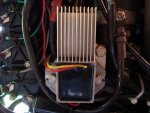Re: If you have high charge voltage, please read
How can I burn my rectifier with a short circuit, if it is like you say?
A rectifier is the most basic form of digital electronics. It is either ON or OFF. It has no in between. If it is ON then the voltage is 0.7V regardless of how much current you dump through it. If it is OFF then it does not conduct electricity. It is the reed valve of electronics that forces electrons to flow in one direction only. The lowest reverse breakdown voltage made is 350V. You can't buy anything less in a rectifier no matter how much you spend or who makes it. It is the nature of silicone.
Since outboard stators are not capable of 350V then there are only three ways to damage a boat rectifier -
1 - hit it with something like a hammer
2 - improper mounting that causes it to overheat
3 - short circuit from high current source such as 12V auto battery across a forward diode/rectifier junction.
You have eliminated #1 and #2. I come from the school of mechanics that says problems left unsolved usually return. An open or corroded connection would not harm a rectifier if you ran your boat for 1000 years. Just not possible. It would take something like a polarity reverse that shorted battery positive to ground through the rectifier and/or stator. If you did not find, identify, or correct the root cause then your charging problems will probably be back. Eventually it could possibly take out your stator.
The mount should ideally be a large slab of metal such as starter bracket or intake manifold. If the heat has nothing to escape into then the silicone will burn itself out. If that is where you mounted your rectifier then I suspect your problem was inadequate heatsinking. I don't see anything that would have absorbed heat. At speed a regulator is going to put out about as much heat as a 75W light bulb and a rectifier about 12W.
The unit in picture has integrated heat sink. As long as you keep a good flow of air across the aluminum fins it should be okay within rated amps. The hotter it runs the more likely it is to break.






















